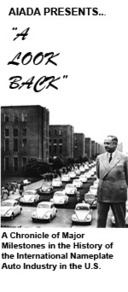A Look Back: How Free Trade Policy Impacted the U.S. Auto Industry
By AIADA Staff
On first glance, the title of this article seems counterintuitive. In everyday commerce “free trade” is a vague enough phrase so that it’s come to be used by advocates and opponents in a manner that confuses a large policy issue to an ever greater degree than such macro issues normally command.
But the facts about free trade and the auto industry come into clear focus when viewed from the vantage point of the last 30 years.
 |
Today, the American automobile industry is the largest it has ever been, with annual sales of nearly 17 million new vehicles, and that number is expected to top 20 million by the end of the decade. The cars, SUVs, trucks and specialty vehicles offered to the consumer are the most affordable and safest ever built, with features available among all price points that were barely even conceived of as little as ten years ago. [One of the humorous downsides to the state of the modern automobile is that manufacturers have the increasingly difficult task of creating concept cars that can truly wow the public.]
The road to today, however, was fraught with obstacles that at times seemed insurmountable, and the solution – free trade – at times seemed to be the worst route to creating the modern healthy state of affairs.
It was the introduction of what were originally known as “foreign cars,” however, achieved by a series of running policy battles, that have made possible much of the innovation and literally all of the growth in the American automotive industry of the past 25 years. America is home today to dozens of new auto manufacturing plants, hundreds of thousands of jobs and billions in investments by global corporations. This phenomenon was only made possible through the successful fight to either repeal or avoid excessive tariffs that would have kept innovation and competition from the marketplace.
This cause and effect relationship can easily be seen by looking at what happened in the early 80s. In 1981, in response to UAW workers taking sledgehammers to foreign cars, Congress attempted to impose quotas on Japanese imports. As a result of actions by AIADA officials and other free trade advocates, the bill died in committee, though the Voluntary Export Restraint (VER) program was implemented – a tariff scheme that has been estimated to have cost consumers $13 billion. The very next year, Honda opened the first International nameplate manufacturing plant in America – and today, the Marysville, Ohio plant is still providing jobs to American workers and continuing to expand.
In 1989, protectionist elements attempted to squash innovation once more, by proposing a $2,500 tariff on each imported SUV, passenger van and light truck. This was a tactic to expand an obscure 1963 tariff originally crafted on imported light trucks in response to a West German tariff on U.S. chicken exports. The proposed rule effectively robbed consumers of choice in the marketplace and would have stifled the imperative to continually improve all automobiles. It was also costing International nameplate dealers $2 million a day.
Once again, AIADA and other free trade advocates were able to make the case against protectionism, which eventually led to SUVs and vans being exempted from the rule, and once again creating the groundwork for sales, employment and investment growth. However, light trucks are still subject to the so-called “Chicken Tax,” keeping a huge segment of the industry from enjoying the fruits of innovation. The skirmish lines in this battle have continually shifted over the decades. Armed now with empirical data on the benefit of free trade, AIADA continues to work on this issue, which will eventually bend to history.
The VER, which ran from 1981-1995, was not the only program that was limiting consumers’ access to choice and stifling innovation. In 1991, European automakers were hit with a 10 percent “luxury tax” on vehicles retailing for over $30,000.
And in 1995, Congress threatened Japanese luxury brands with a 100 percent tariff that would have effectively ended the grand experiment [Lexus, Infiniti, Acura] that has literally revolutionized the global luxury automobile market. Through a combined whirlwind effort of AIADA officials and dealer members – nearly 1,000 of whom traveled to D.C. to fight against an industry-killing tax. That effort was successful and the tariff was avoided.
Which brings us back again to the present. In 2006, while the sometimes esoteric arguments for and against free trade continue to swirl in government and in the headlines as the domestics continue to lose market share and grapple with a costly legacy structure, the facts speak for themselves.
In January, AIADA traveled to Thailand, the world’s second largest producer of light pickup trucks, to voice our support for repeal of the 25 percent tariff. Unfortunately, with the recent Thai elections subsequent, free trade talks between the U.S. and Thailand have been temporarily put on hold. We are hopeful, however, that with the new USTR the U.S. will reengage soon and will we too see an end to this antiquated and prohibitive tariff.
Free trade is not the problem. Allowing all companies to compete fairly in the marketplace has brought the American automobile industry to unprecedented heights of success – for consumers, for entrepreneurs and workers, and for the economy.
May 1, 13:20 PM 2006


